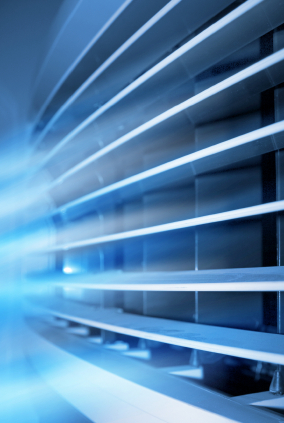
We heat and cool our home to keep our family comfortable. With some homes, maintaining a consistent temperature within each room of the home can prove to be difficult. Some home airflow problems are easy to remedy, others require a more comprehensive approach. Solving home airflow problems can provide many benefits for indoor air quality, energy efficiency, and home comfort. Below are seven common problems and solutions to improving your home airflow.
Leaky Air Ducts
Repairing leaky air ducts is the single best thing a homeowner can do to solve airflow problems within a home. When constructed, air ducts are sleeved and screwed into one another to deliver and draw air throughout the home. In most ventilation systems, the joined sections are not air tight allowing for conditioned air to escape or be drawn from unintended areas. Seal the joints of your air ducts with an approved mastic or sealant and you will realize a noticeable and immediate improvement to your homes airflow problems.
Distance from the Furnace and Air Conditioner
As the furnace or air conditioning system is in operation, it blows and draws air through a series of air ducts to condition each space of the home. While there is a strong force of air pressure as the air is blown from the furnace or air conditioner, the strength of the airflow dissipates as it reaches the outer extremities of the ventilation system. More often than not this airflow problem relates to poor design in the architecture of the home or poor installation practices of the HVAC system. In some occasions, modifications can be made to the ventilation system to provide a greater volume of air with less restriction. In most cases the most efficient and cost effective solution is to install zones within the ventilation system which are dampers that regulate air flow.
Lack of Return Air
Proper airflow within a home is always related to the circulation of air flow. Your home relies on supply air vents which blow conditioned air into the home, and return air vents which draw the air back to the furnace or air conditioner. A lack of return air vents decreases the circulation of airflow within a home, adding additional return vents in areas with limited airflow will improve a homes air circulation.
Dirty Fan Blower
Within the furnace or air conditioner cabinet there is a fan-blower which distributes the air. Overtime dust and debris builds on the fan blower blades reducing its ability to sheer and distribute the air. By routinely cleaning the furnace on an annual basis you can improve your homes airflow.
Clogged Air Conditioner Coil
If you have air conditioning, located above your furnace cabinet is an evaporative coil which is made up of tiny fins that absorb heat and cool the air. Overtime dust and debris builds up within the coil fins reducing the amount of airflow that the furnace can distribute. By routinely cleaning the evaporative coils on an annual basis you can improve your homes airflow.
Improperly Sized Heating and Cooling Equipment
Prior to installation, a HVAC load calculation is performed to determine the amount of heating and cooling BTU’s are required to effectively condition the temperature of the home. If the HVAC system is under-sized or over-sized it will create home airflow problems. An experienced HVAC technician can provide an HVAC load calculation to make sure that the HVAC is sized properly for the home.
Disconnected & Crushed Air Ducts
If there is no airflow or very limited airflow it may be related to a disconnected or crushed air duct. Disconnected or crushed air ducts occur from faulty installation. Remove the air vent register and inspect the ventilation line with a flashlight and mirror. If the ventilation line is disconnected and is within an area that can be reached, refasten the ducting together with sheetmetal screws and seal the joint. If the ducting is crushed, remove the crushed ducting piece and replace it. There are occasions where the duct disconnection cannot be seen, in this scenario you will need the ventilation line to be scoped with a fiber-optic camera to determine the location of the disconnection and the best options to gain access for its repair.


 National Jewish Health and Ductworks, Inc. are collaborating for the second year during National Asthma and Allergy Month, (May) to provide a comprehensive approach for people with allergies and asthma to help them learn if the environment in their homes is contributing to their illness. National Jewish has developed a diagnostic kit to assess the allergen levels in indoor environments.
National Jewish Health and Ductworks, Inc. are collaborating for the second year during National Asthma and Allergy Month, (May) to provide a comprehensive approach for people with allergies and asthma to help them learn if the environment in their homes is contributing to their illness. National Jewish has developed a diagnostic kit to assess the allergen levels in indoor environments. Mold contamination within air duct systems can pose detrimental health effects to building occupants if left uncorrected. If mold exists within your air ducts make a plan to investigate the source of the problem, isolate the problem area, and remove the contaminants.
Mold contamination within air duct systems can pose detrimental health effects to building occupants if left uncorrected. If mold exists within your air ducts make a plan to investigate the source of the problem, isolate the problem area, and remove the contaminants. Air duct cleaning service providers may tell you that they need to apply a chemical biocide to the inside of your ducts to kill bacteria (germs), and fungi (mold) and prevent future biological growth. Careful consideration should be taken before allowing the application of chemicals within your air ducts. Due to the varying ranges of temperature, humidity and air turbulence there are very few chemicals that are approved for the use within ventilation systems.
Air duct cleaning service providers may tell you that they need to apply a chemical biocide to the inside of your ducts to kill bacteria (germs), and fungi (mold) and prevent future biological growth. Careful consideration should be taken before allowing the application of chemicals within your air ducts. Due to the varying ranges of temperature, humidity and air turbulence there are very few chemicals that are approved for the use within ventilation systems. Pet urine within the air ducts is an extremely unpleasant odor. Sometimes trouble shooting where the pet urine odor is coming from can be quite difficult. Here are some great instructions on how to remove pet urine odor from air ducts.
Pet urine within the air ducts is an extremely unpleasant odor. Sometimes trouble shooting where the pet urine odor is coming from can be quite difficult. Here are some great instructions on how to remove pet urine odor from air ducts. Regional climate plays a large role in Indoor Air Quality and comfort. Regional climate characteristics are determined by geographic location and long term weather conditions. Two of the most important factors that affect an areas climate are temperature and precipitation.
Regional climate plays a large role in Indoor Air Quality and comfort. Regional climate characteristics are determined by geographic location and long term weather conditions. Two of the most important factors that affect an areas climate are temperature and precipitation. Asthma is one of the most common chronic diseases in the world, affecting more than 300 million people worldwide. It is characterized by recurrent breathing problems and symptoms such as breathlessness, wheezing, chest tightness, and coughing. Asthma symptoms vary over time, and also from individual to individual.
Asthma is one of the most common chronic diseases in the world, affecting more than 300 million people worldwide. It is characterized by recurrent breathing problems and symptoms such as breathlessness, wheezing, chest tightness, and coughing. Asthma symptoms vary over time, and also from individual to individual.